IEC 60870-5-104 Driver
Not counted towards your tag license limit.
IEC 60870-5 refers to a collection of standards produced by the International Electrotechnical Commission, or IEC, to provide an open standard for the transmission of SCADA telemetry control and information. IEC 60870-5-104 provides for communications over networks using the TCP/IP protocol suite.
Related application properties
The following property settings hold additional configuration parameters for your IEC 60870-5-104 driver:
IECFailoverCount – Count of errors before a soft failover to a redundant server is attempted. Defaults to 10.
IECPropagateOnlyOnDataChange - If set, driver will not process incoming data if it hasn't changed since the last read. Note that this setting does not apply to history reads or event log reads (which are always processed). Defaults to 1.
The ID tab of every tag includes the same common elements: Name, Area, Description, and Help ID.
Name:
Uniquely identifies each tag in the application. If the tag is a child of another, the parent names will be displayed in a separate area before the name field.
You may right-click on the tag's name to add or remove a conditional start expression.
Area
The area field is used to group similar tags together. By defining an area, you make it possible to:
- Filter for particular tag groups when searching in the tag browser
- Link dial-out alarm rosters to Alarm tags having a particular area
- Limit the number of tags loaded upon startup.
- Filter the alarm display to show only certain areas.
- Filter tag selection by area when building reports
When working with Parent-Child tag structures, the area property of all child tags will automatically match the configured area of a parent. Naturally, you can change any tag's area as required. In the case of a child tag, the field background will turn yellow to indicate that you have applied an override. (Orange in the case of user-defined types. Refer to Configuration Field Colors)
To use the area field effectively, you might consider setting the same Area for each I/O driver and its related I/O tags to group all the tags representing the equipment processes installed at each I/O device. You might also consider naming the Area property for the physical location of the tag (i.e. a station or name of a landmark near the location of the I/O device). For serial port or Roster tags, you might configure the Area property according to the purpose of each tag, such as System or Communications.
You may define as many areas as you wish and you may leave the area blank for some tags (note that for Modem tags that are to be used with the Alarm Notification System, it is actually required that the area field be left blank).
To define a new area, type the name in the field. It will immediately be added. To use an existing area, use the drop-down list feature. Re-typing an existing area name is not recommended since a typo or misspelling will result in a second area being created.
There is no tool to remove an area name from VTScada since such a tool is unnecessary. An area definition will exist as long as any tag uses it and will stop existing when no tag uses it (following the next re-start).
Description
Tag names tend to be brief. The description field provides a way to give each tag a human-friendly note describing its purpose. While not mandatory, the description is highly recommended.
Tag descriptions are displayed in the tag browser, in the list of tags to be selected for a report and also on-screen when the operator holds the pointer over the tag’s widget. For installations that use the Alarm Notification System, the description will be spoken when identifying the tag that caused the alarm.
The description field will store up to 65,500 characters, but this will exceed the practical limits of what can be displayed on-screen.
This note is relevant only to those with a multilingual user interface:
When editing any textual parameter (description, area, engineering units...) always work in the phrase editor. Any changes made directly to the textual parameter will result in a new phrase being created rather than the existing phrase being changed.
In a unilingual application this makes no difference, but in a multilingual application it is regarded as poor practice.
Help Search Key
Used only by those who have created their own CHM-format context sensitive help files to accompany their application.
Server List
Select (or create) a named server list.
IEC 60870-5-104 Driver properties Communications
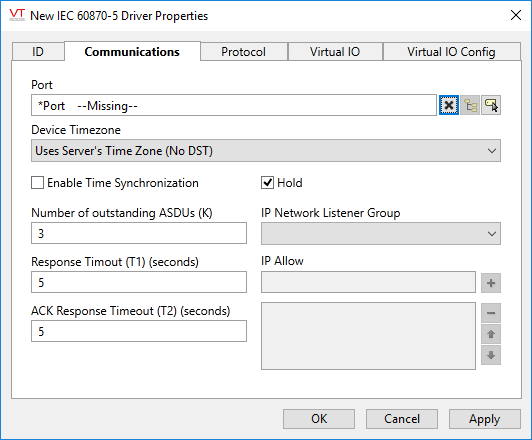
Port
The VTScada port tag that will be used by the driver. Note that the IEC-60870 5-104 driver uses port #2404
Device Timezone
The time zone of the clock in the IEC-60870-5-104 device. This is used to correct the time-stamped readings read from the device by VTScada for storage in its historian in UTC format.
- Uses Server Time Zone (no DST) – assumes that the device is in the same time zone as the server. Take care to ensure that the server does not use daylight savings time.
- Device Clock In UTC – the clock in the device is set to UTC. Strongly recommended.
- Actual Time Zone – select the actual time zone, in which the device is located.
Enable Time Synchronization
Controls whether a time synchronization message is sent to the device on establishing a communications session. If selected, time synchronization is enabled. By default, no time synchronization is performed.
Hold
Select this to have I/O tags attached to the driver hold their last value in the event of a communication failure. If not selected, tags will have their value set to invalid on a communication failure.
Number of Outstanding ASDUs (K)
Specifies the number of Application Service Data Units (ASDUs) that can be received before sending an acknowledgment. The value, K, is defaulted to 3.
Response Timeout (T1) (seconds)
Time to wait for a response before reporting an error. T1 has a default of 5 seconds.
ACK Response Timeout (T2) (seconds)
Time to wait before sending an ACK (S Type Message) in the absence of any other communications. T2 has a default of 5 seconds.
IP Network Listener Group
Configure only if this driver is to accept in-bound TCP or UDP communications. Select an existing IP Network Listener tag using the drop-down list. If the IP Network Listener is configured, this driver must use the VRTU, configured on the VRTU tab.
IP Allow
Optional. Misconfiguration of this field is a common source of problems.
Used in connection with an IP Network Listener tag. General IP address filtering should be set on the IP Network Listener, as this will be more efficient. The list of allowed IP addresses in the driver is intended to prevent misconfigured devices from interfering with other devices.
Both filters (that in the Network Listener and this one) can be configured at the same time. The filter in the IP Network Listener will be applied when the device first connects and the local filter will be applied after a specific driver instance has been identified.
IEC 60870-5-104 Driver Configuration - Protocol
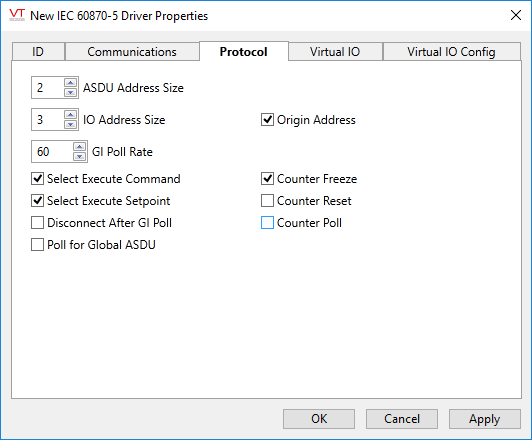
ASDU Address Size
Specifies the size of the Application Service Data Unit in the protocol in number of bytes. This can either be 1 or 2, where the default is 2.
IO Address Size
Specifies the size of the Information Object Address (IOA) in the protocol in number of bytes. This can either be 1 or 2, where the default is 2.
Origin Address
Specifies whether the Origin Address should be included in the protocol messages. Enabled by default.
GI Poll Rate
Specifies the rate in seconds at which a general interrogation will be requested.
Note that if the Device is connected and a session is established, a general interrogation is not necessary and will not be performed.
Select Execute Command
If selected, a command will send a Select message before an Execute message.
Otherwise, only an execute message will be sent.
Select Execute Setpoint
If selected, a Setpoint will send a Select message before an Execute message.
If not true, only an execute message will be sent.
Disconnect After GI Poll
Specifies whether the connection should be closed after a general interrogation (GI)poll.
Poll for Global ASDU
When VTScada (as a master) connects to other IEC devices, it makes an interrogation inquiry to ask the device to send all of it's configured values. If the Poll from Global ASDU is selected, that request is broadcast to all connected devices, therefore VTScada will get data for all of the devices on the network, regardless of whether that data is needed.
If this option is not selected (default), VTScada will make individual requests to each ASDU configured within VTScada only.
Counter Freeze
Specifies whether a counter should be frozen while it is being read.
Counter Reset
Specifies if a counter should be reset after it has been read.
Counter Poll
Specifies whether a counter should be polled.
IEC 60870-5-104 Driver Configuration - Virtual IO
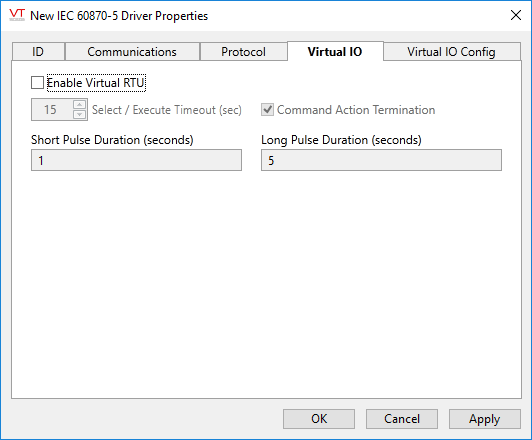
Enable Virtual RTU
Specifies whether this instance of the IEC Driver will operate in a Slave Configuration. If selected, the Virtual RTU functions are enabled and the driver will respond to IEC 60870-5-104-104 master requests.
Select / Execute Timeout (s)
Duration in seconds of a Select or Execute command.
Command Action Termination
Specifies whether an ACT-TERM message is sent following an ACT-CONF message.
Short Pulse Duration (s)
The duration in seconds of a Short Pulse for a command operations.
Long Pulse Duration (s)
The duration in seconds of a Long Pulse for a command operations.
IEC 60870-5-104 Driver Configuration - Virtual IO Config
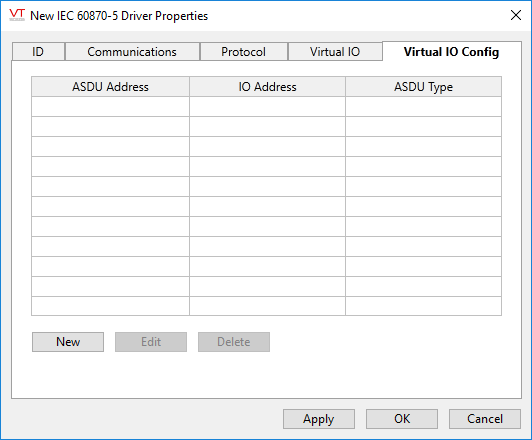
ASDU Address
The Application Service Data Unit (ASDU) address of the data item. This is an integer between 1 and 65534.
IO Address
The Information Object Address (IOA) of the data item.
ASDU Type
Specify the Application Service Data Unit type of the data item.
New / Edit / Delete
Dialogs for working with entries in this table. Note that the Delete tool will not prompt for confirmation.
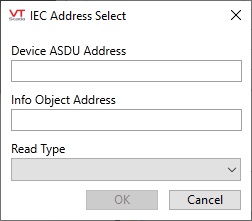
The following widgets are available to display information about your IEC 60870-5-104 driver tags:
IEC 60870-5-104 Communication Messages Dialog
